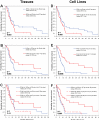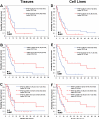B-RAF and N-RAS mutations are preserved during short time in vitro propagation and differentially impact prognosis
- PMID: 17311103
- PMCID: PMC1794595
- DOI: 10.1371/journal.pone.0000236
B-RAF and N-RAS mutations are preserved during short time in vitro propagation and differentially impact prognosis
Abstract
In melanoma, the RAS/RAF/MEK/ERK signalling pathway is an area of great interest, because it regulates tumor cell proliferation and survival. A varying mutation rate has been reported for B-RAF and N-RAS, which has been largely attributed to the differential source of tumor DNA analyzed, e.g., fixed tumor tissues or in vitro propagated melanoma cells. Notably, this variation also interfered with interpreting the impact of these mutations on the clinical course of the disease. Consequently, we investigated the mutational profile of B-RAF and N-RAS in biopsies and corresponding cell lines from metastatic tumor lesions of 109 melanoma patients (AJCC stage III/IV), and its respective impact on survival. 97 tissue biopsies and 105 biopsy-derived cell lines were screened for B-RAF and N-RAS mutations by PCR single strand conformation polymorphism and DNA sequencing. Mutations were correlated with patient survival data obtained within a median follow-up time of 31 months. B-RAF mutations were detected in 55% tissues and 51% cell lines, N-RAS mutations in 23% tissues and 25% cell lines, respectively. There was strong concordance between the mutational status of tissues and corresponding cell lines, showing a differing status for B-RAF in only 5% and N-RAS in only 6%, respectively. Patients with tumors carrying mutated B-RAF showed an impaired median survival (8.0 versus 11.8 months, p = 0.055, tissues; 7.1 versus 9.3 months, p = 0.068, cell lines), whereas patients with N-RAS-mutated tumors presented with a favorable prognosis (median survival 12.5 versus 7.9 months, p = 0.084, tissues; 15.4 versus 6.8 months, p = 0.0008, cell lines), each in comparison with wildtype gene status. Multivariate analysis qualified N-RAS (p = 0.006) but not B-RAF mutation status as an independent prognostic factor of overall survival. Our findings demonstrate that B-RAF and N-RAS mutations are well preserved during short term in vitro propagation and, most importantly, differentially impact the outcome of melanoma patients.
Conflict of interest statement
Figures




Similar articles
-
Effect of common B-RAF and N-RAS mutations on global gene expression in melanoma cell lines.Carcinogenesis. 2005 Jul;26(7):1224-32. doi: 10.1093/carcin/bgi066. Epub 2005 Mar 10. Carcinogenesis. 2005. PMID: 15760917
-
Detection of B-RAF and N-RAS mutations in human melanoma.J Am Coll Surg. 2005 Mar;200(3):362-70. doi: 10.1016/j.jamcollsurg.2004.10.032. J Am Coll Surg. 2005. PMID: 15737846
-
Frequent alterations of Ras signaling pathway genes in sporadic malignant melanomas.Int J Cancer. 2004 Apr 10;109(3):377-84. doi: 10.1002/ijc.11722. Int J Cancer. 2004. PMID: 14961576
-
B-RAF: A contributor to the melanoma phenotype.Int J Biochem Cell Biol. 2011 Jan;43(1):29-32. doi: 10.1016/j.biocel.2010.09.015. Epub 2010 Sep 29. Int J Biochem Cell Biol. 2011. PMID: 20883818 Review.
-
BRAF Mutation Status Concordance Between Primary Cutaneous Melanomas and Corresponding Metastases: A Review of the Latest Evidence.Actas Dermosifiliogr. 2017 Dec;108(10):894-901. doi: 10.1016/j.ad.2016.12.025. Epub 2017 Jul 12. Actas Dermosifiliogr. 2017. PMID: 28711165 Review. English, Spanish.
Cited by
-
Low BRAF and NRAS expression levels are associated with clinical benefit from DTIC therapy and prognosis in metastatic melanoma.Clin Exp Metastasis. 2013 Oct;30(7):867-76. doi: 10.1007/s10585-013-9587-4. Epub 2013 May 15. Clin Exp Metastasis. 2013. PMID: 23673558 Free PMC article.
-
A simple immunoassay for extracellular vesicle liquid biopsy in microliters of non-processed plasma.J Nanobiotechnology. 2022 Feb 8;20(1):72. doi: 10.1186/s12951-022-01256-5. J Nanobiotechnology. 2022. PMID: 35135541 Free PMC article.
-
Clinical Pharmacokinetic and Pharmacodynamic Considerations in the (Modern) Treatment of Melanoma.Clin Pharmacokinet. 2019 Aug;58(8):1029-1043. doi: 10.1007/s40262-019-00753-5. Clin Pharmacokinet. 2019. PMID: 30868471 Review.
-
BRAFV600E mutations in malignant melanoma are associated with increased expressions of BAALC.J Carcinog. 2008 Jul 16;7:1. doi: 10.1186/1477-3163-7-1. J Carcinog. 2008. PMID: 18631381 Free PMC article.
-
Systematic screening of isogenic cancer cells identifies DUSP6 as context-specific synthetic lethal target in melanoma.Oncotarget. 2017 Apr 4;8(14):23760-23774. doi: 10.18632/oncotarget.15863. Oncotarget. 2017. PMID: 28423600 Free PMC article.
References
-
- Satyamoorthy K, Li G, Gerrero MR, Brose MS, Volpe P, et al. Constitutive mitogen-activated protein kinase activation in melanoma is mediated by both BRAF mutations and autocrine growth factor stimulation. Cancer Res. 2003;63:756–759. - PubMed
-
- Davies H, Bignell GR, Cox C, Stephens P, Edkins S, et al. Mutations of the BRAF gene in human cancer. Nature. 2002;417:949–954. - PubMed
-
- Brose MS, Volpe P, Feldman M, Kumar M, Rishi I, et al. BRAF and RAS mutations in human lung cancer and melanoma. Cancer Res. 2002;62:6997–7000. - PubMed
-
- Akslen LA, Angelini S, Straume O, Bachmann IM, Molven A, et al. BRAF and NRAS mutations are frequent in nodular melanoma but are not associated with tumor cell proliferation or patient survival. J Invest Dermatol. 2005;125:312–317. - PubMed
Publication types
MeSH terms
Substances
LinkOut - more resources
Full Text Sources
Other Literature Sources
Medical
Research Materials
Miscellaneous

